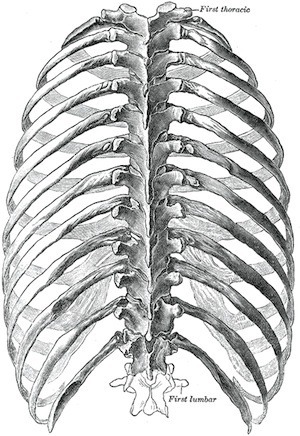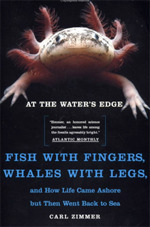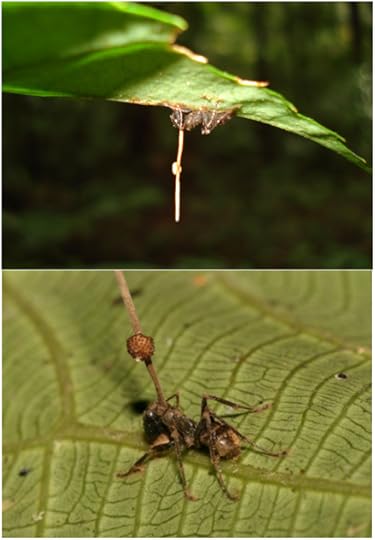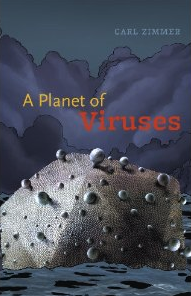Carl Zimmer's Blog, page 64
May 18, 2011
The art of storytelling at the World Science Festival
 The World Science Festival is gearing up for its third year in New York, and I'm delighted to participate once more. This time I'll be talking about a topic near and dear to my heart–telling stories about science. On Thursday June 2, they'll have a full day of scientist-writers, television producers, and science writers.
The World Science Festival is gearing up for its third year in New York, and I'm delighted to participate once more. This time I'll be talking about a topic near and dear to my heart–telling stories about science. On Thursday June 2, they'll have a full day of scientist-writers, television producers, and science writers.
Here's the lineup (go to the festival site to purchase tickets):
Science on Screen
Thursday, June 2, 2011
(9:00 – 10:00)
Participants: Bill Weir, Louie Psihoyos, Simon Singh, Howard Swartz
Fantastic imagery and groundbreaking journalism dominate the best of documentary science storytelling. Director Louie Psihoyos' Oscar-winning documentary The Cove (2009) stands as one of the most audacious and dangerous-to-film operations in the history of the conservation movement. NOVA's Emergency Mine Rescue (2010) chronicled the unprecedented technological feat of rescuing 33 trapped Chilean miners. Today's best producers of on-screen science are pushing the envelope, using a range of computer-based tools—including the highly cinematic techniques of digital science animation—to take viewers on a swooping ride through previously unseen worlds. How do these newly available techniques influence and enhance their editorial judgment? And what stories of science are ...

The Journey of the Neuron: My latest column for Discover
[image error]Our neurons exist in a staggering vast network, with 100 billion cells forming some 100 trillion connections. And it's up to these ordinary cells to form that network on their own, snaking across the brain or even across the body, in order to find the right target. In my latest column for Discover, I look at new research that reveals some of the elegantly simple tricks our nervous system uses to wire itself. Check it out.

May 16, 2011
Swimming robots and flexing bones: My new story for the New York Times
 Biomechanics is the science of flesh and bone–how birds fly, sharks swim, muscles twitch, and tendons spring. In January, I went to a fascinating session at the annual meeting of the Society for Integrative and Comparative Biology where biomechanics experts talked about how they've been trying to turn their insights about biomechanics into commercial products. One of the most surprising examples came from Charles Pell, a North Carolina inventor, who explained how surgical tools could be much improved by taking biomechanics into account. I later paid Pell a visit at the offices of his company, Physcient, to find out more about their first creation: a rib spreader that promises to spread ribs without breaking them. The result was an article which appears in today's New York Times. Check it out.
Biomechanics is the science of flesh and bone–how birds fly, sharks swim, muscles twitch, and tendons spring. In January, I went to a fascinating session at the annual meeting of the Society for Integrative and Comparative Biology where biomechanics experts talked about how they've been trying to turn their insights about biomechanics into commercial products. One of the most surprising examples came from Charles Pell, a North Carolina inventor, who explained how surgical tools could be much improved by taking biomechanics into account. I later paid Pell a visit at the offices of his company, Physcient, to find out more about their first creation: a rib spreader that promises to spread ribs without breaking them. The result was an article which appears in today's New York Times. Check it out.
[Image: Gray's Anatomy]

We'd rather sell than pack!
 The Zimmer clan is preparing for some renovations to the house, which means boxing up all my books. We've got a particularly tall stack of copies of my first book, At the Water's Edge: Fish with Fingers, Whales With Legs, and How Life Came Ashore and Went Back to the Sea. We'd rather sell these books than pack them. And so, from today till Friday, I'll be offering autographed copies at my Amazon store for the low, low price of $5. (Imagine me shouting all this, Crazy-Eddie style.)
The Zimmer clan is preparing for some renovations to the house, which means boxing up all my books. We've got a particularly tall stack of copies of my first book, At the Water's Edge: Fish with Fingers, Whales With Legs, and How Life Came Ashore and Went Back to the Sea. We'd rather sell these books than pack them. And so, from today till Friday, I'll be offering autographed copies at my Amazon store for the low, low price of $5. (Imagine me shouting all this, Crazy-Eddie style.)
If you're not familiar with the book, you can check out its carlzimmer.com page or check out this review in Times Higher Education, in which the reviewer writes, "It is wicked, I know, but I have the habit of turning over the corners of pages whenever I chance upon something unexpectedly interesting, exciting or informative. Zimmer's At the Water's Edge quickly became the most dog-eared book on my shelves."

May 13, 2011
Should we save smallpox? A conversation with Richard Preston
[image error]Each Friday this month, I'm having a conversation about viruses to mark the publication of my new book A Planet of Viruses. Last week, I talked to virologist Ian Lipkin about the search for new viruses and their potential to alter our behavior. Today, I'm delighted to talk with Richard Preston, the author of the Hot Zone and other books on viruses. He and I discuss the fate of smallpox. The worst viral killer in the history of civilization is now wiped off the face of the Earth, except for some laboratory stocks. Preston and I take on the question of whether we should now annihilate it. Check it out.

May 11, 2011
What's so special about dinosaurs?

 Long, long ago–actually, in 2006–I wrote an article for the New York Times about a very strange relative of today's alligators and crocodiles. Effigia, which lived 210 million years ago, did not slouch around inTriassic swamps. Instead, it stood on two big hind legs, holding its front legs–arms, really–aloft. It looked an awful lot like a bipedal dinosaur, despite the fact that the ancestors of dinosaurs and crocodiles split off 250 million years ago.
Long, long ago–actually, in 2006–I wrote an article for the New York Times about a very strange relative of today's alligators and crocodiles. Effigia, which lived 210 million years ago, did not slouch around inTriassic swamps. Instead, it stood on two big hind legs, holding its front legs–arms, really–aloft. It looked an awful lot like a bipedal dinosaur, despite the fact that the ancestors of dinosaurs and crocodiles split off 250 million years ago.
As just one species standing upright, Effigia might have been an evolutionary fluke. But today at Science Now, Brian Switek writes that a contemporary relative of Effigia was a biped, too. So now it appears that there was a lineage of crocodile relatives running around upright at the same time as some dinosaurs were too. The dinosaurs went on to fame and glory–or, at any rate, a continued upright existence. The crocodile lineage ended up on all fours, where they remain today.
[Reconstruction by Carl Buell]
May 9, 2011
More eldritch ant horror!
 It's time to pay another visit to Cordyceps, the fungus that turns its hosts into spore-sprouting zombies.
It's time to pay another visit to Cordyceps, the fungus that turns its hosts into spore-sprouting zombies.
The fungus, which can be found in many parts of the tropics, penetrates an insect's exoskeleton and then work its way into its host's body. At first the ant seems normal to the human eye, but eventually it makes its way to a leaf, where it clamps down with its mandibles. Cordyceps then sprouts out of the ant's body, lashing it to the leaf's underside, and producing a long stalk tipped with spores. The spores can then shower down on unfortunate insects below.
David Hughes of Penn State University has been publishing a string of fascinating papers in recent years about this science-fiction-topping parasite. In 2009, I wrote about one study of his on the exquisite precision of the fungus's manipulations. He and his colleagues found that one species that lives in Thailand almost always causes infected ants to clamp onto a leaf vein about 25 centimeters off the ground–a spot where the humidity and other conditions may be ideal for a fungus to grow. When Hughes and his colleagues moved infected ants higher up into the canopy, the fungus ...

Your viral Monday: podcasts from the Guardian, NPR, and more
1. On Friday, I talked to Ira Flatow about A Planet of Viruses. The podcast is now available here.
2. I also spoke to the Guardian's Alok Jha for their Science Weekly podcast. You can listen to that here.
3. Tomorrow around 9:30 am EST I'll be on Newstalk, an Irish radio network.
4. Thursday I'll be giving a lecture at California State University Fresno.
5. Sunday I'll be talking about the book in Los Angeles and Irvine CA. Details here.
CreatureCast presents the baroque life on a lobster
The folks at CreatureCast have created a new animation about the weirder corners of zoology. Behold Symbion pandora, an animal that clings to the mouthparts of lobsters, where it engages in the weirdest sex life I've ever heard of.
A new gig: The Council for the Advancement of Science Writing
I'm pleased to report that I've just been appointed to the board of directors of the Council for the Advancement of Science Writing. It's a venerable organization that's been around for fifty years, dedicated to improving the quality of science news reaching the public. Their programs include the New Horizons in Science briefing, which brings together leading scientists with journalist to talk about cutting-edge research. We're already scheming about some new ideas to use twenty-first century tools to help science writers–and readers–in new ways. I'll keep you posted.
















